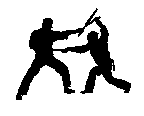|








|
History of Modern Arnis
The Philippines is an island nation in
the Western Pacific where over 70 dialects are spoken. Over the
centuries, the Philippines has been a crossroads for countries
and empires trading and fighting with each other. It has been a
country of two classes--the rich and the poor. To survive in the
streets and in the rice fields, one has to have skill in the use
of bladed weapons. In some regions today, most rural men carry
swords to the field for use as a tool for cutting and for
protection.
The Philippine martial arts assume
different names in different regions of the country. Over 50
styles exist or have existed until recent times. Regardless of
the style, the most common names of these arts are Kali, Eskrima
or Arnis.
The evolution of Arnis from a bladed
weapon into its present systematic martial art form spans a
history of over a thousand years. Due to a lack of written
records, it is difficult for researchers to determine its precise
evolution to the modern times. Much of the ancient art of arnis
remains mystery-shrouded.
The term 'Kali' may be derived from the
native fencing/war dance of Tjakalele (cha-ka-lee-lee) found in
Indonesia. According to historians, the Ten Datus of Borneo
brought their martial art style to the central Philippine island
of Panay while fleeing from Datu Makatunaw of Java in the 12th
century. Later, in the 16th century Filipinos incorporated
European fencing methods into arnis under the influence of
Spanish colonization.
Originally, fighting was done with a
spear and shield. However, fighters learned that using two canes
or swords was more mobile and superior to the shield and spear.
Eventually, fighters learned to adopt a single cane or sword with
a check hand to defeat double cane fighters. Thus Solo Baston
(single cane fighting) became the foundation of Modern Arnis
training
Today, Modern Arnis has three forms of
fighting. They are Espada y Daga (sword and dagger), Sinawali or
Doble Baston (double cane fighting), and Solo Baston (single cane
fighting). Traditionally, in the Philippine martial arts, the
student first learns how to handle and defend against weapons.
Later on, the student is trained to defend with his or her feet
and hands. The rationale is that (1) training cane to cane is
safer than taking punches and kicks to the body and (2) if you
can defend yourself against a weapon then defending against
punches and kicks will come easily because training with canes
reduces the chances of making errors in self-defense.
This martial art springs from the need
of people in the Philippines to defend themselves and their
families in a modern world. Some of the most well-known styles of
Kali, Esicrima or Arnis known today are Arnis de Mano, Modern
Amis, Pekiti Tersia, Doce Pares Eskrima, Balintawak, Cabales
Serrada, Pananandata and Modern Arnis. Numerous other systems
have developed especially from those who emigrated to the United
States this century. Modern Arnis is a composite of various
classical and modern fighting systems used in the Philippines.
This curriculum offers the Presas System
of Modern Arnis developed by Grandmaster Ernesto Presas and
Grandmaster Fred Lazo of the Philippines.
Modern Arnis is a safe and effective way
to practice the traditional martial arts of the Philippines. This
art includes cane handling, footwork drills, self-defense
releases, traps, cane disarms, joint locks, and empty-hands
techniques.

|